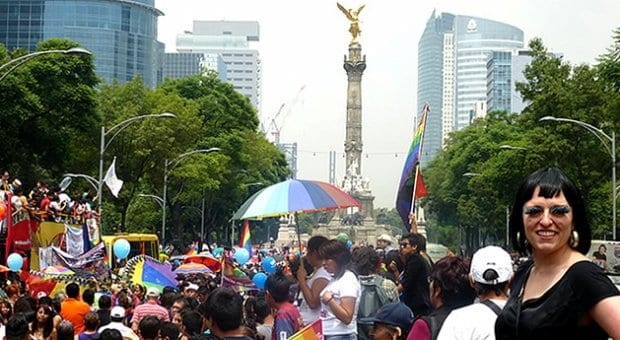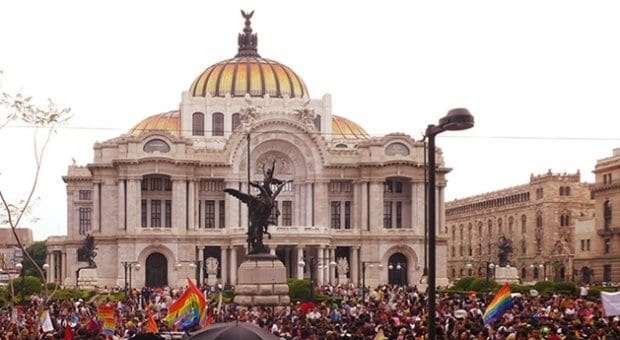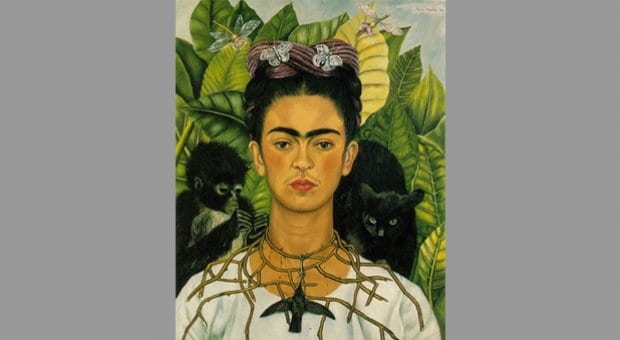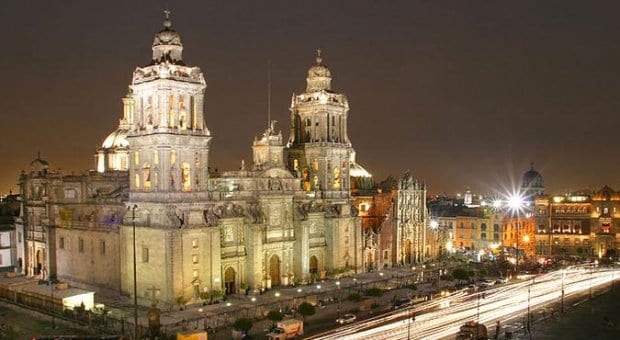
Mexico City's Pride march takes over Paseo de la Reforma, where "El Ángel" glitters in the sun. Credit: Keph Senett

Palacio des Bellas Artes houses murals by Rufino Tamayo, José Clemente Orozco and Diego Rivera. Credit: Keph Senett

Self-portrait by famed painter (and bisexual) Frida Kahlo. Credit: Frida Kahlo
At nearly 1,500 square kilometres, with 16 boroughs and hundreds of neighbourhoods, Mexico City (known colloquially as “el DF,” short for Distrito Federal) is home to almost nine million people. A leader in human rights (in 2009, the city legalized same-sex marriage), with a rich and varied LGBT scene, DF is an exciting, safe and welcoming destination. You could spend a lifetime exploring the region; here are a few places to get you started.
Zona Rosa
With a storied past of splendour and eventual decline, the Zona Rosa is now a tourist-friendly shopping and entertainment district in Colonia Juárez. Home to the gay village, it’s the perfect place to get your feet wet as you begin to discover LGBT Mexico City. Covering approximately 24 blocks, the area is easily walkable, but if you get lost, just ask for directions to El Ángel de la Independencia (the city’s most famous monument is located at the western edge of the Zona Rosa on Paseo de la Reforma).
Dip into the LGBT scene at lesbian bookstore and café Voces en Tinta, and check their bulletin board for local events listings. At nearby Rainbow Land, you can find everything from mugs, to underpants emblazoned with — you guessed it — rainbows, and if you can’t find what you’re looking for there, check out Esfera, at Liverpool 165-J, for more clothing and accessories. The Zona Rosa is also the place to pick up new leather, condoms, lube and sex toys — check any of the several outlets of Erotika Love Store (also pick up your copy of Anal Magazine at their counters).
The neighbourhood is accessible to tourists, so you’ll find all sorts of chain establishments, from Starbucks to MacDonald’s, here, but it’s also the site of a burgeoning Korean community. Try Cheong Ki Wa at Amberes 41. Those looking for high-end Mexican (and a piece of history) can visit Fonda el Refugio, open since 1954 and reported to be a favourite of Liz Taylor’s.
The party in Zona Rosa goes late, and there are plenty of venues to visit, so pace yourself. Start the night off at La Botica, an upscale mezcaleria with several locations throughout the city. Mixed groups of boys and girls can head to Botas Bar, at Nizas 45, where go-go dancers (go-gas, for the women) perform on two floors. Cabaretito has several venues with different shows; check their site. Finally, Lipstick/Kinky Bar at Amberes 1 is a mainstay, with two floors of dancing, a karaoke room and a women’s night every Thursday.
Metro stop:
Insurgentes (Line 1, pink)
Condesa/Roma
Green and artsy, adjacent colonias Condesa and Roma districts are the perfect base for artists, bohemians and foodies. Characterized by bookstores, boutiques and an unending selection of restaurants, Condesa and Roma provide an excellent city-break setting for a day or a month.
With tons of incidental natural space (Condesa’s Avenida Amsterdam, for example, is a giant, tree-lined track that itself surrounds Parque México), this area is also within walking distance of Chapultepec Park. Aside from being enormous (at 686 hectares, it’s the largest city park in Latin America and has been referred to as “the lungs of the city”), Chapultepec Park is also the site of numerous museums, including Museo Nacional de Antropología, a zoo, a castle, a botanical garden, several markets and kilometres of pathways. Pay special attention to the gate that runs along Paseo de la Reforma; exhibits are regularly installed there. Speaking of exhibits, you can easily stroll Condesa and Roma on a DIY art walk. Some of the area’s many small galleries are on Avenida Colima.
When it’s time to eat, the only problem you’ll have is deciding where. Taco stands and food trucks abound — try as many as you can (with a special mention to the bright red Vlad Mayab truck parked at Tlaxcala and Insurgentes, which serves Yucatecan fare). There’s no need to stick to national flavours, though. Foods from around the world — and an array of interesting fusion combinations — can be found in Condesa and Roma. Try Musuko for sushi, and pay attention to the day: Mondays and Thursdays, women get 40 percent off their entire bill; Tuesdays and Fridays, men get the same deal, bringing an additional layer of meaning to the term “meat market.” For your choice of several upscale restos, stroll the section of Álvaro Obregón between Frontera and Tonalá. Also keep an eye out for any of numerous establishments advertising locally sourced organics and coffee, or even better, book a food tour with Sabores México and sample everything from Oaxacan tlayudas to French pâté.
If, after your explorations, you decide you want to stay, check out the gay-owned and -operated Red Tree House B&B, conveniently located right where one neighbourhood meets the other.
Metro stops:
Cuauhtémoc, Insurgentes, Sevilla, Chapultepec, Juanacatlán (Line 1, pink)
Niños Héroes, Hospital General, Centro Médico (Line 3, green)
Patriotismo, Chilpancingo (Line 9, orange)
El Centro Historico
The Centro Historico was the original foundation of Mexico City and features some buildings dating back as far as the 16th century. This UNESCO world heritage site is made for walking (or cycling; on Sundays Avenido Reforma is closed to vehicular traffic), and the Zócalo — the second largest public plaza in the world, dwarfed only by Moscow’s Red Square — is the best place to start. First stop is at the east side of the square, which is entirely occupied by the Palacio Nacional, a historic and beautiful structure that is free to enter (you will have to go through a metal detector).
A second, smaller and venerable gay village can be found on Republica de Cuba, four blocks north and to the west of the Zócalo. El Viena, at 2-E, is the city’s only gay cantina, and there are numerous bars, clubs and lounges — all gay-friendly — between it and cabaret La Perla, at 44. Check out Marrakech Salon, at 18, for dancing with a young and mixed crowd, and La Purísima for drinks served in an atmosphere that salaciously mixes sex and religion.
Metro stops:
Pino Suárez, Isabel la Católica, Salto del Agua (Line 1, pink)
Zócalo, Allende, Bellas Artes, Hidalgo, Revolución (Line 2, blue)
Hidalgo, Juarez (Line 3, green)
Coyoacán
No guide to LGBT Mexico City would be complete without a mention of Coyoacán, if only for the fact that it’s home to La Casa Azul, the indigo house where famed painter (and bisexual) Frida Kahlo spent the last years of her life. The area is rich with history from the artist’s life, including her time married to Diego Rivera and her friendship with Leon Trotsky. Currently, La Casa Azul is a museum detailing the life, loves and art of Kahlo. Nearby, you can visit the Museo Diego Rivera, at Museo 150, and the Museo Leon Trotsky, at Viena 45.
Mexican writer and intellectual Salvador Novo was also a resident of Coyoacán. An out gay man during the mid-1900s, Novo has been compared to Oscar Wilde. Though he died in 1974, the street on which he lived still bears his name. Visit Calle Salvador Novo in Barrio de Santa Catarina.
Metro stops:
Coyoacán, Viveros, Miguel Ángel de Quevedo (Line 3, green)

 Why you can trust Xtra
Why you can trust Xtra